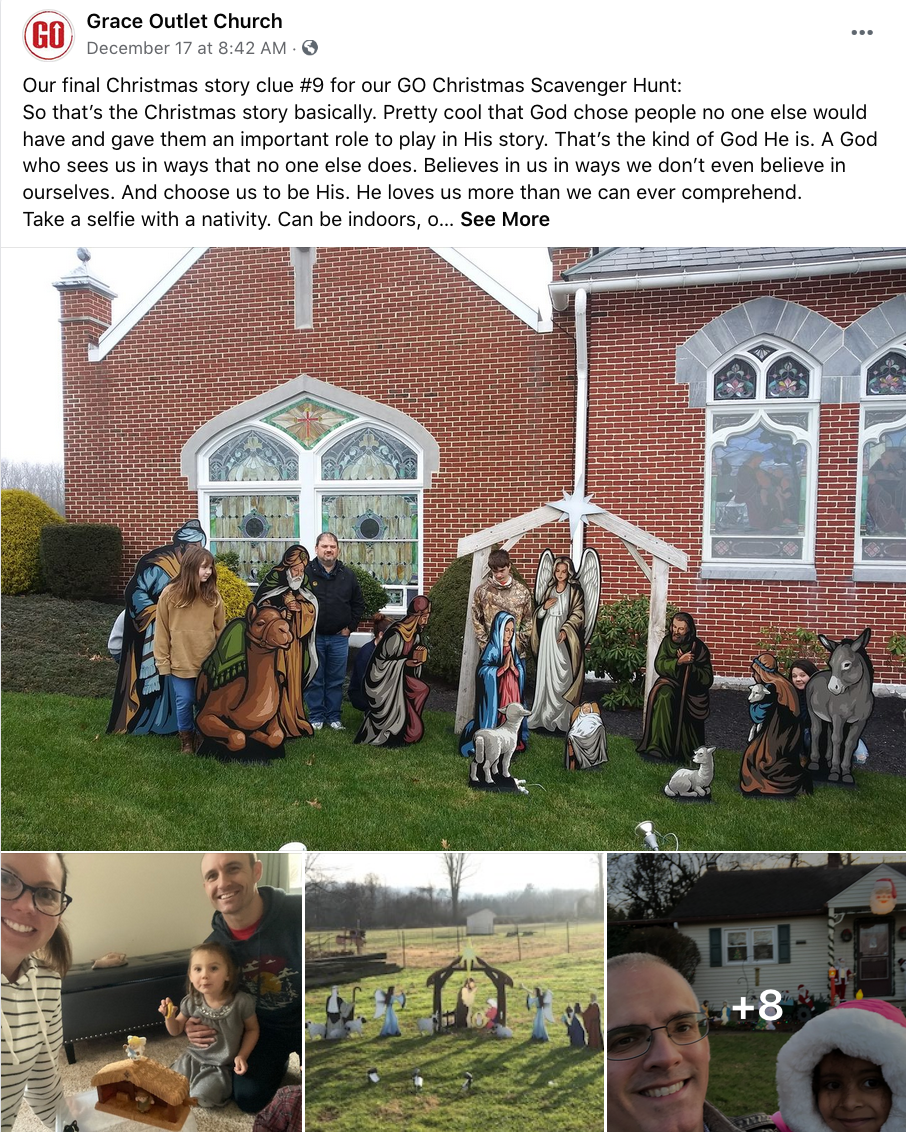
Tips for Building a Better Social Media Ministry
Story by V. Michelle Bernard
Ten months into the pandemic, many churches and schools are still meeting virtually. The Visitor staff asked leaders around the union what they’ve learned about online ministry during this time, and gleaned tips on how local leaders can make the most of these important communication tools—no matter how long the pandemic continues.
Building on a Strong Foundation
Early into the pandemic, the Allegheny East Conference Metropolitan church’s communication team, led by Natasha Iheme, realized that social media was the main portal to reach members and the community. They were already using Instagram, Facebook and Twitter, but in 2020, started posting all of their events on these outlets, and also used LinkedIn as a resource to help members with employment opportunities. The church’s team, based in Hyattsville, Md., also reinvigorated their YouTube channel, which had been dormant for the last several years.
“We've been intentional about interacting online with our members and continually encouraging those who are not connected to get involved, get connected and get active,” says Iheme. “It's a work in progress.”
 She also notes, “That content doesn’t need to be perfect, but some thought should go into it. Take into consideration who you are trying to reach, and what is the expected outcome.”
She also notes, “That content doesn’t need to be perfect, but some thought should go into it. Take into consideration who you are trying to reach, and what is the expected outcome.”
Victoria Turrentine, the church’s content writer specialist, adds that it is important to show what the church is doing in the community. “People need to know the church still cares. When the church shows they are committed to the people through social media, it would allow viewers to become involved and/or share those same ideas with their church to grow the kingdom of God.”
To make it come together, Denise Dixon, social media content specialist urges other church communicators to “ensure you have dedicated volunteers that understand that messages placed on social media should [also] be tailored to gain the interest of non-believers and non-members.”
It Doesn’t Have to Be Fancy
During the pandemic, WGTS 91.9, based in Rockville, Md., has also increased the social media side of their ministry.
“We have seen more engagement on our social media channels, especially Facebook Live,” says Jerry Woods, promotions director and morning show host. “When the pandemic started, afternoon show host Stacey Stone launched PrayerWorks Live, a daily Facebook Live where she prays with listeners, and it has become increasingly popular.”
 In addition to other events, the WGTS 91.9 Summer Concert Series has moved online. “It's really pushed us to try new things, but it's also helped us grow,” says Woods. “A typical summer concert sees 5,000 people on the plaza at Tysons Corner Center mall. The online shows had 10,000 and 15,000 people. That growth was very exciting for our team because it means more ministry and it goes way beyond the Washington, D.C., area. We literally heard from viewers from most of the states, as well as countries around the world.”
In addition to other events, the WGTS 91.9 Summer Concert Series has moved online. “It's really pushed us to try new things, but it's also helped us grow,” says Woods. “A typical summer concert sees 5,000 people on the plaza at Tysons Corner Center mall. The online shows had 10,000 and 15,000 people. That growth was very exciting for our team because it means more ministry and it goes way beyond the Washington, D.C., area. We literally heard from viewers from most of the states, as well as countries around the world.”
Woods thinks that success on social media comes down to livestream events. “It doesn't have to be fancy. It can just be you talking to an audience on your cell phone. Just make sure you have something compelling to say. Take the livestream opportunity to talk to your ministry community.” He adds that whenever they do a live event, they always have a team of people dedicated to taking prayer requests and answering comments from viewers.
Build Relationships Intentionally
The Pennsylvania Conference, the first to hold an online constituency meeting, has also offered training to members who want to share the gospel through social media, resulting in hundreds of digital media missionaries and trained digital media Bible workers who share Bible studies online.
In addition to online worship and meetings, Grace Outlet in Reading hosted online socials, including scavenger hunts, that inspired members to join who hadn’t attended worship in several months.
In January, church leaders are planning an escape room social via Facebook. Several members will be “locked” inside the church building. Other members will work together online to help the trapped members solve clues and escape from the building without setting off the alarms.
Tamyra Horst, conference communication director and the church’s relationship coordinator, says, “Recognize that social media is people—just like members coming to your building—and treat them like you would [treat] people inside your building. … I am intentionally looking for ways to build relationships not only within the building, but online too.”
 Horst adds that just like how the church schedules greeters for in person worship, she schedules livestream greeters too. “[We make sure] someone is intentional at connecting and engaging people. Not just posting a comment that says, ‘Happy Sabbath, we’re glad you’re here,’ but seeking to connect and engage.”
Horst adds that just like how the church schedules greeters for in person worship, she schedules livestream greeters too. “[We make sure] someone is intentional at connecting and engaging people. Not just posting a comment that says, ‘Happy Sabbath, we’re glad you’re here,’ but seeking to connect and engage.”
She encourages communicators to remember they also have “visitors” on social media. “Look for ways you can connect with those visiting your social media posts. … Definitely engage in some way with every comment,” she says.
Individual members not involved in official communication ministry can also make an impact in their spheres, which are as unique as their personalities.
“Share your faith on social media however God has called you to,” says Anthony Hackett, director of SONset Friday Entertainment, who produces Christian entertainment and shares inspiration with social media followers. “It will be ‘pushy’ or ‘preachy’ to some, and there is nothing you can do about it, but for others it will be exactly what God needed them to hear/ see.”
Horst adds, “What works best online is also what works best in person—sharing what God is doing in your life; not preaching. It doesn’t have to be long. It can be simple, such as ways God has blessed; answered prayers; challenges you face that God spoke into powerfully; ways you’ve seen Him at work around you. People can argue with our doctrines and prophecies, but they can’t argue with our stories. They are our stories, our experiences.—Horst
7 Tips for Social Media Ministry
- “People are online, so we have to go to where the people are. It is important to know that social media can and should be used as an evangelistic tool. Start simple with Facebook and the free version of an online posting tool, such as Hootsuite, to assist with posting content consistently.”—Natasha Iheme
- “Encourage the younger generation who are already online to help with creating content and posting online. … They are already doing it every day.”—Natasha Iheme
- Livestreamed events don’t have to be fancy. “It can just be you talking to an audience on your cell phone. Just make sure you have something compelling to say. Take the livestream opportunity to talk to your ministry community.”—Jerry Woods
- Remember churches have “visitors” on social media too. “Look for ways you can connect with those visiting your social media posts.”—Tamyra Horst
- “Ministry is something that needs to always evolve and change to meet the needs and connect with the people where they are. Right now, they’re online. So let’s recognize that. Not fight it.”—Horst
- “In [2021], you should never see bad video or audio quality ... ever.”—Anthony Hackett
“Put members of the younger generations in positions of leadership and authority to be able to further God’s message to this new and continually changing generation [on social media].”—Hackett
Resources for Digital Evangelism
- Dos and Don'ts of Church Social Media
- How to Overcome the Biggest Obstacles When Starting Your Online Ministry
- How to Use WhatsApp for Evangelism
- Online Evangelism Toolkit 1.0
- Should Churches Consider Facebook Ads?
- 5 Ways to Win Onlie Arguments
- 6 Creative Ways to Use Facebook Live for Evangelism
 Read and share articles from the January/February 2021 Visitor:
Read and share articles from the January/February 2021 Visitor:
- Feature: Small Steps, Big Miracles
- Editorial: Bible Gazers
- Columbia Union Conference Elects New Executive Secretary
- Columbia Union Shares Second Round of COVID-19 Relief Funds
- La Unión Elige Nuevo Secretario Ejecutivo
- Miracle in a Bathtub
- Personal Evangelism Tips
- Tips for Building a Better Social Media Evangelism Ministry
- Words of Life: Welcome to the Year of the Bible

Add new comment